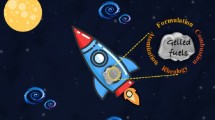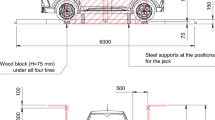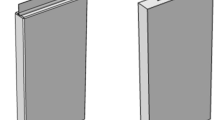Abstract
The characteristics of a fuel spray atomized by a steam jet were studied using the method of shadow photography. The studied method of forming a two-phase flow for dispersing liquid fuel allows application of a wide range of hydrocarbons and increases the service life of the combustion equipment due to the absence of fuel spraying nozzles. Using a long-focus macroscopic lens, the dispersed composition of spent engine oil was measured at various fuel supply frequencies: 10, 25, and 40 Hz. The dispersed phase velocity was determined using the PIV-algorithms; it amounted to 60 m/s for all studied regimes. It is shown that the frequency of liquid fuel supply does not affect the size and velocity of the formed fuel droplets.
Similar content being viewed by others
References
S. Hummel, H.J. Berner, F. Altenschmidt, M. Schenk, and M. Bargende, Investigations on the spray-atomization of various fuels for an outwardly opening piezo injector for the application to a pilot injection passenger car gas engine, SAE Technical Papers, 2020, Art. No. 2020-01-2117.
S. Manipurath, Experimental study of superheated kerosene jet fuel sprays from a pressure-swirl nozzle, Proc. ASME Turbo Expo, 2017, Paper No. G-T2017-64846.
J. Jedelsrý and M. Jícha, Spray characteristics and liquid distribution of multi-hole effervescent atomizers for industrial burners, Applied Thermal Engng., 2016, Vol. 96. P. 286–296.
M. Mlkvik, J. Jedelsky, H.P. Karbstein, and V. Gaukel, Spraying of viscous liquids: influence of fluid-mixing mechanism on the performance of internal-mixing twin-fluid atomizers, Appl. Sci., 2020, Vol. 10, P. 5249.
A.M. Danis, I. Namer, and N.P. Cernansky, Droplet size and equivalence ratio effects on spark ignition of monodisperse N-heptane and methanol sprays, Combustion and Flame, 1988, Vol. 74, Iss. 3, P. 285–294.
U. Ağbulut, M.K. Yeşilyurt, and S. Sarıdemir, Wastes to energy: Improving the poor properties of waste tire pyrolysis oil with waste cooking oil methyl ester and waste fusel alcohol — a detailed assessment on the combustion, emission, and performance characteristics of a CI engine, Energy, 2021, Vol. 222, P. 119942–1–119942–15.
G.S. Nyashina, M.A. Kurgankina, and P.A. Strizhak, Environmental, economic and energetic benefits of using coal and oil processing waste instead of coal to produce the same amount of energy, Energy Conversion and Management, 2018, Vol. 174, P. 175–187.
Y. Kalinci and I. Dincer, Waste energy management, Comprehensive Energy Systems, 2018, Vol. 5, P. 91–133.
K. Tainaka, Y. Fan, N. Hashimoto, and H. Nishida, Effects of blending crude Jatropha oil and heavy fuel oil on the soot behavior of a steam atomizing burner, Renewable Energy, 2019, Vol. 136, P. 358–364.
G.G. Pereira, P.W. Cleary, and Y. Serizawa, Prediction of fluid flow through and jet formation from a high pressure nozzle using Smoothed Particle Hydrodynamics, Chem. Engng Sci., 2018, Vol. 178, P. 12–26.
P.D. Hede, P. Bach, and A.D. Jensen, Two-fluid spray atomization and pneumatic nozzles for fluid bed coating / agglomeration purposes: a review, Chem. Engng Sci., 2008, Vol. 63, Iss. 14, P. 3821–3842.
Patent RF, 2219455, RF MPK51F23C 11/00, F23L 7/00, Sootless fuel combustion method, M.S. Vigriyanov, V.V. Salomatov, S.V. Alekseenko, patent holder IT SB RAS, M.S. Vigriyanov, V.V. Salomatov, S.V. Alekseenko, No. 202103813/06; appl. 11.02.2002; publ. 20.12.2003, Bull. No. 35.
I.S. Anufriev, E.Yu. Shadrin, E.P. Kopyev, S.V. Alekseenko, and O.V. Sharypov, Study of liquid hydrocarbons atomization by supersonic air or steam jet, Applied Thermal Engng, 2019, Vol. 163, P. 114400–1–114400–12.
I.S. Anufriev and E.P. Kopyev, Diesel fuel combustion by spraying in a superheated steam jet, Fuel Processing Technology, 2019, Vol. 192, P. 154–169.
I. Anufriev, E. Kovyev, S. Alekseenko, O. Sharypov, E. Butakov, M. Vigriyanov, and I. Sadkin, Cleaner crude oil combustion during superheated steam atomization, Thermal Sci., 2021, Vol. 25, No. 1, Part A. P. 331–345.
I.S. Anufriev, E.P. Kopyev, I.S. Sadkin, and M.A. Mukhina, Diesel and waste oil combustion in a new steam burner with low NOX emission, Fuel, 2021, Vol. 290, P. 120100–1–120100–9.
I.S. Anufriev, E.P. Kopyev, I.S. Sadkin, and M.A. Mukhina, NOx reduction by steam injection method during liquid fuel and waste burning, Process Safety and Environmental Protection, 2021, Vol. 152, P. 240–248.
S.V. Alekseenko, I.S. Anufriev, M.S. Vigriyanov, E.P. Kovyev, I.S. Sadkin, and O.V. Sharypov, Burning of heavy fuel oil in a steam jet in a new burner, J. Appl. Mech. Tech. Phys., 2020, Vol. 61, No. 3, P. 324–330.
I.S. Anufriev, D.V. Krasinsky, E.Yu. Shadrin, E.P. Kopyev, and O.V. Sharypov, Investigation of the structure of the gas flow from the nozzle of a spray-type burner, Thermophysics and Aeromechanics, 2019, Vol. 26, No. 5, P. 657–672.
T. Osipowicz and K. Prajwowski, Possibilities of research electromagnetic fuel injectors, J. of KONES Powertrain and Transport, 2017, Vol. 24, No. 2, P. 167–175.
I.S. Anufriev, E.Yu. Shadrin, E.P. Kopyev, and O.V. Sharypov, Experimental investigation of size of fuel droplets formed by steam jet impact, Fuel, 2021, Vol. 303, P. 121183–1–121183–7.
Patent RF, 2740722 RF MPK51F23D 11/20, F23L 7/00, Steam oil burner, M.S. Vigriyanov, I.S. Anufriev, E.P. Kopyev, I.S. Sadkin, O.V. Sharypov, No. 2020119233; patent holder IT SB RAS; appl. 03.06.2020; publ. 20.01.2021, Bul. 2.
I.S. Anufriev, S.V. Alekseenko, E.P. Kopyev, and O.V. Sharypov, Combustion of substandard liquid hydrocarbons in atmosphere burners with steam gasification, J. Engng Thermophys., 2019, Vol. 28, P. 324–331.
Author information
Authors and Affiliations
Corresponding author
Additional information
The dispersed composition of the fuel spray was studied with the financial support of the Russian Foundation for Basic Research (Project No. 20-58-00046) and BRFFR (project No. T20R-344) as part of a joint scientific project. High-speed visualization was funded by the Russian Science Foundation (Project No. 19-79-30075).
Rights and permissions
About this article
Cite this article
Shadrin, E.Y., Sadkin, I.S., Kopyev, E.P. et al. Characteristics of a fuel spray atomized with a steam jet. Thermophys. Aeromech. 29, 579–585 (2022). https://doi.org/10.1134/S0869864322040102
Received:
Revised:
Accepted:
Published:
Issue Date:
DOI: https://doi.org/10.1134/S0869864322040102




